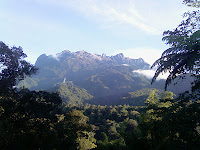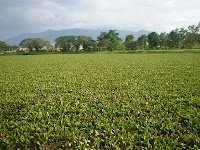This retention pond located in the centre of Taman Lintang Makmur, just behind Sungai Siput TF Value Mart. The area is about 5 acre. The developer of Sungai Siput Business Centre made use of the charm of this pond as their selling point i.e. it named Sungai Siput Waterfront Business Centre! The developer promised that the pond will be turn into a recreation centre; however, now it looks like a field! Sungai Siput Waterfront is the world 1st. waterfront without water now!
Many people fishing in this pond previously. Some netting fish too. The Indonesian from the nearby construction site catches eels. The irresponsible fishing maniac will just trough the small fishes on to the ground rather than put it back to the pond.
Almost a year ago, the water hyacinth colonised the whole pond.
I have seek opinions and advises from professionals and NGOs' e.g WWF Malaysia and MNS Perak. I was told that the water hyacinth will endanger the ecology system. Ecologically speaking, this species is considered invasive and is regarded as pest. It prevent other semi aquatic plants to co-generate and add biodiversity.
It blocks sunlight and oxygen from water, thus decrease healthy water chemistry. The deprived sunlight contain less aquatic life and prevent the amount of dissolved oxygen that the dwelling organisms will be affected, thus less food for fishes.This noxious weed will definitely affect the retention pond function as it slow down water movement and flows, the volume of water hold will be lesser, its block the water outlets and inlets.
The location of the pond in the middle of a business centre and housing area, it may cause danger for children. Children and sometimes adults will think it is a field rather than a pond.
Clearing the water hyacinth, the ecology of the pond will be stabilise and it will be a thriving place for wetland plants and animals. Over time after removal of the weeds, the pond will settle and stabilise its ecosystem. Lotus shall be plant as the avifauna, insects and other wildlife population will increase as the plant give flowers, good cover and stratification. The flower attract dragonflies and damselflies. The larva of these insects will eat up mosquitoes larvae. This will increased the biodiversity and well being of the pond.
My MNS Perak friend suggested to turn the pond into a beautiful wetland park for education and recreation with landscraping and architecture element incorporated. Its amazing! I hope it will come through.
I will be writing to the Kuala Kangsar Municipality Council and Drainage and Irrigation Department to clean up the retention pond and turn it into a better place for educational purposes.







































